Impact of Inequality and Discrimination on Children, Families, and Staff
VerifiedAdded on 2023/01/17
|12
|3748
|94
AI Summary
This article discusses the impact of inequality and discrimination on children, families, and staff within early years settings. It explores the ways in which inequalities affect individuals and evaluates the practice of challenging inequalities and ensuring inclusion in the curriculum for all children.
Contribute Materials
Your contribution can guide someone’s learning journey. Share your
documents today.
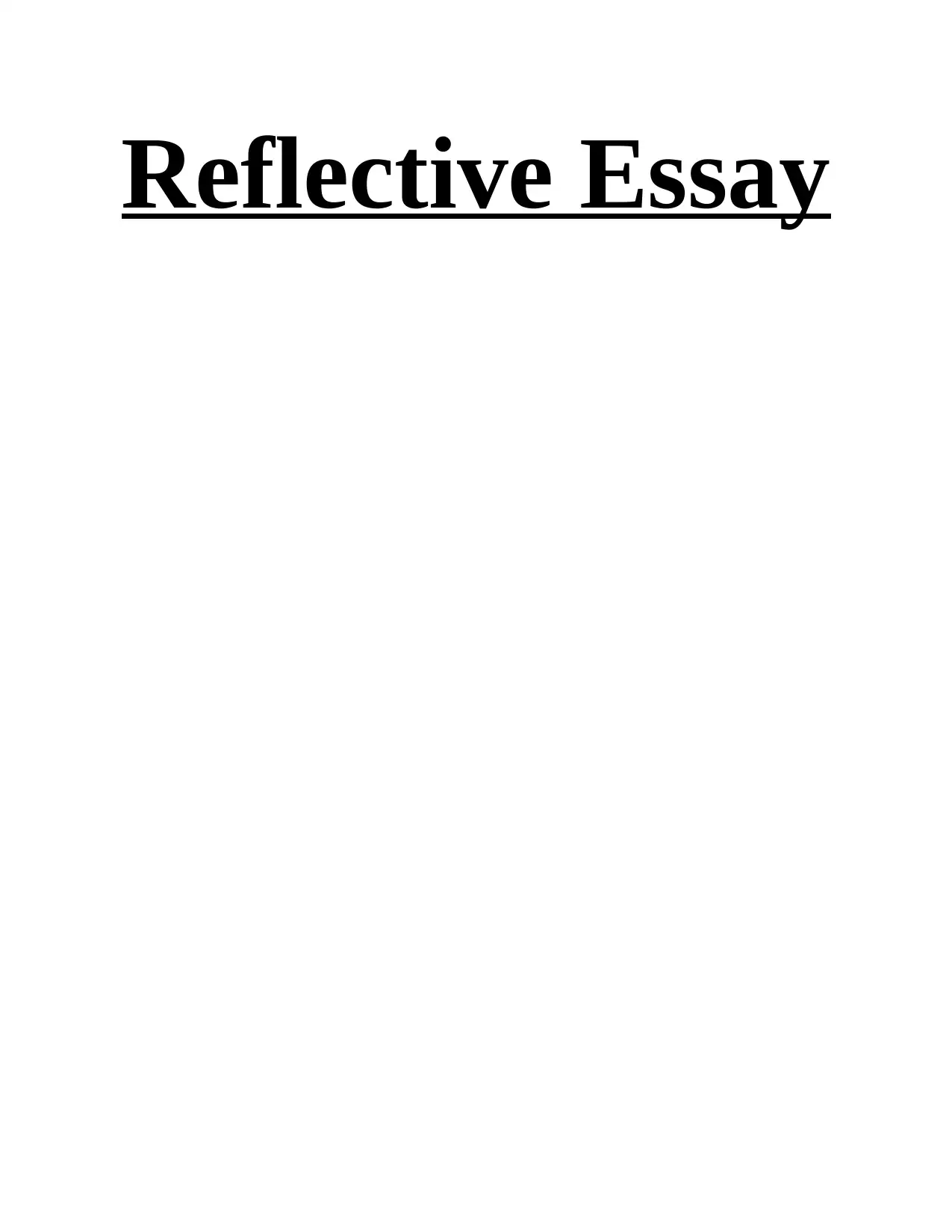
Reflective Essay
Secure Best Marks with AI Grader
Need help grading? Try our AI Grader for instant feedback on your assignments.
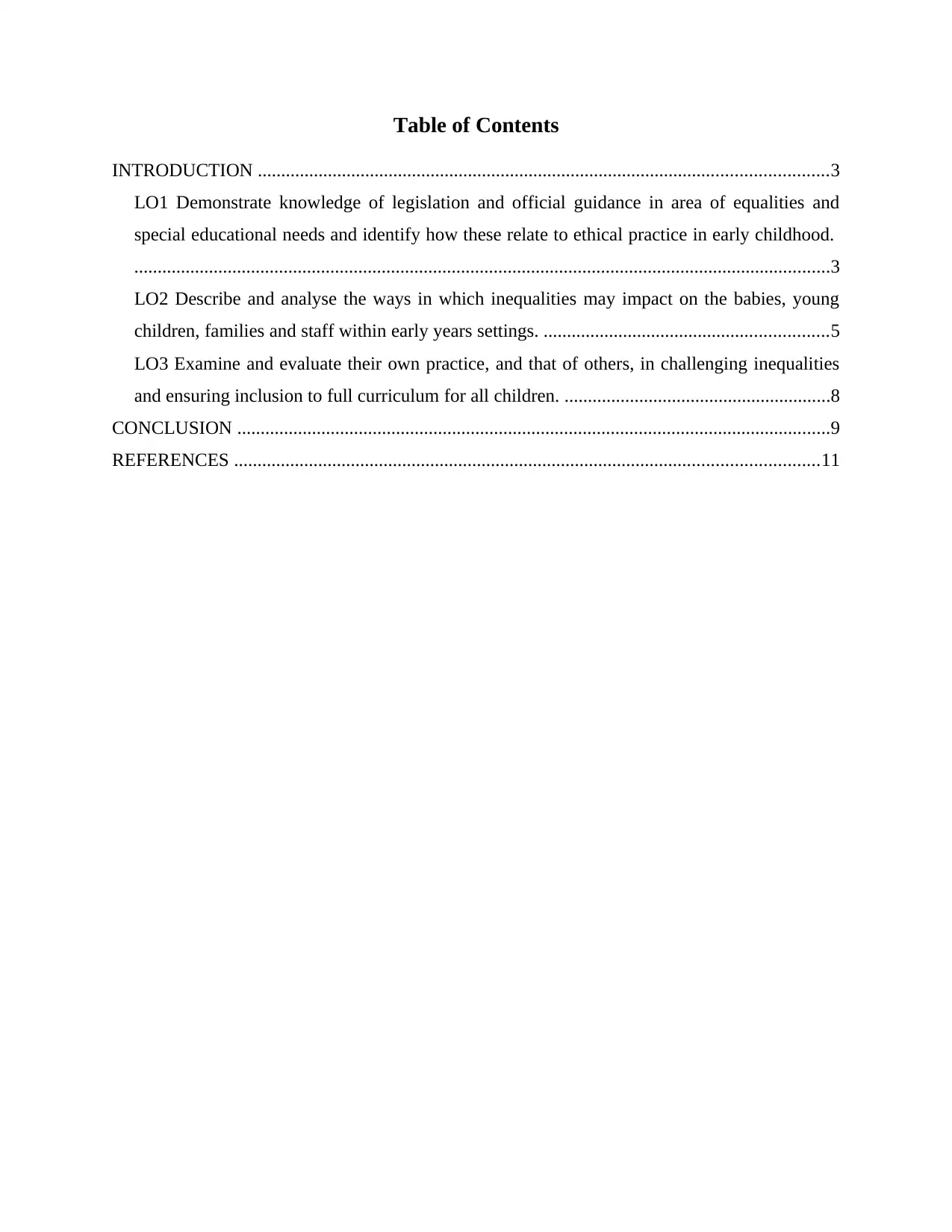
Table of Contents
INTRODUCTION ..........................................................................................................................3
LO1 Demonstrate knowledge of legislation and official guidance in area of equalities and
special educational needs and identify how these relate to ethical practice in early childhood.
.....................................................................................................................................................3
LO2 Describe and analyse the ways in which inequalities may impact on the babies, young
children, families and staff within early years settings. .............................................................5
LO3 Examine and evaluate their own practice, and that of others, in challenging inequalities
and ensuring inclusion to full curriculum for all children. .........................................................8
CONCLUSION ...............................................................................................................................9
REFERENCES .............................................................................................................................11
INTRODUCTION ..........................................................................................................................3
LO1 Demonstrate knowledge of legislation and official guidance in area of equalities and
special educational needs and identify how these relate to ethical practice in early childhood.
.....................................................................................................................................................3
LO2 Describe and analyse the ways in which inequalities may impact on the babies, young
children, families and staff within early years settings. .............................................................5
LO3 Examine and evaluate their own practice, and that of others, in challenging inequalities
and ensuring inclusion to full curriculum for all children. .........................................................8
CONCLUSION ...............................................................................................................................9
REFERENCES .............................................................................................................................11
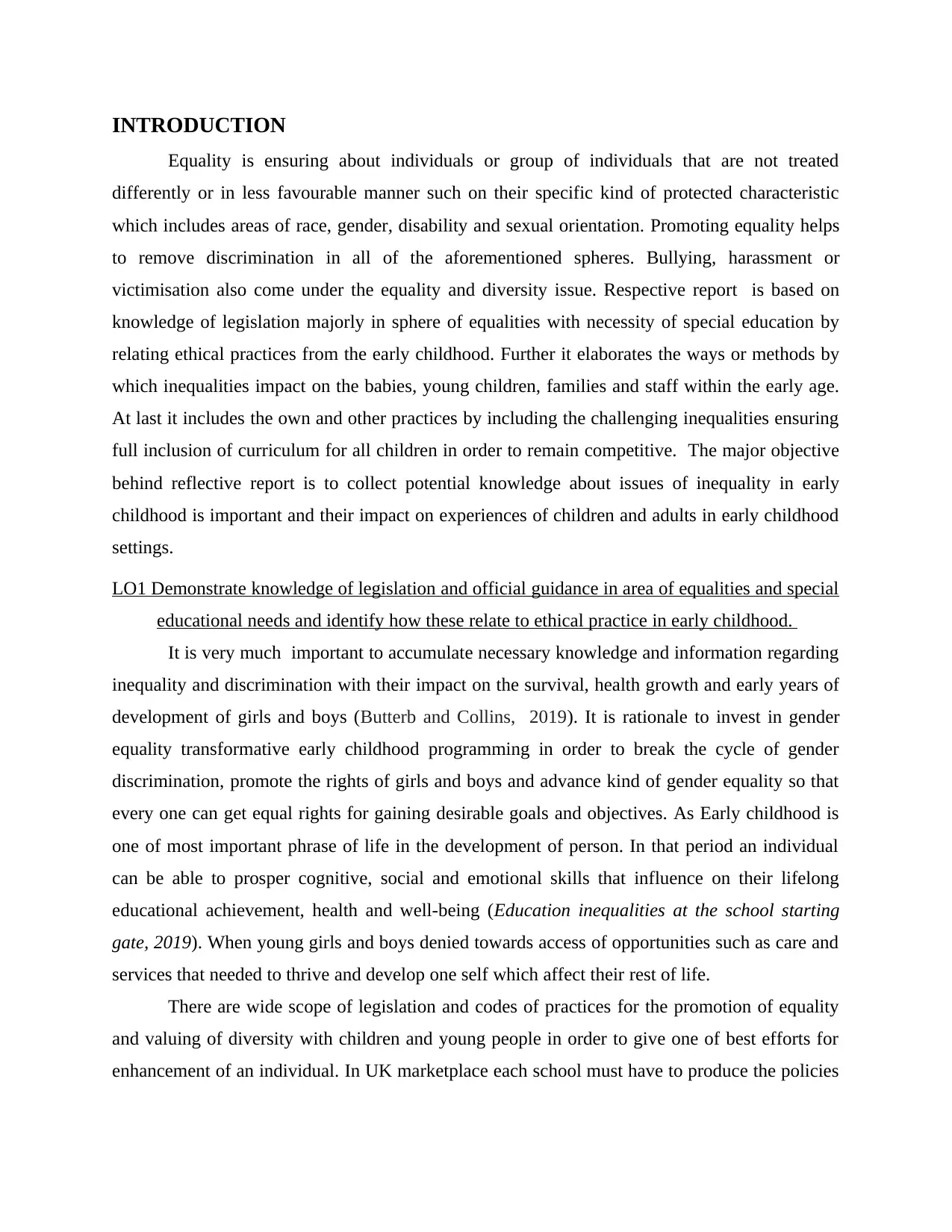
INTRODUCTION
Equality is ensuring about individuals or group of individuals that are not treated
differently or in less favourable manner such on their specific kind of protected characteristic
which includes areas of race, gender, disability and sexual orientation. Promoting equality helps
to remove discrimination in all of the aforementioned spheres. Bullying, harassment or
victimisation also come under the equality and diversity issue. Respective report is based on
knowledge of legislation majorly in sphere of equalities with necessity of special education by
relating ethical practices from the early childhood. Further it elaborates the ways or methods by
which inequalities impact on the babies, young children, families and staff within the early age.
At last it includes the own and other practices by including the challenging inequalities ensuring
full inclusion of curriculum for all children in order to remain competitive. The major objective
behind reflective report is to collect potential knowledge about issues of inequality in early
childhood is important and their impact on experiences of children and adults in early childhood
settings.
LO1 Demonstrate knowledge of legislation and official guidance in area of equalities and special
educational needs and identify how these relate to ethical practice in early childhood.
It is very much important to accumulate necessary knowledge and information regarding
inequality and discrimination with their impact on the survival, health growth and early years of
development of girls and boys (Butterb and Collins, 2019). It is rationale to invest in gender
equality transformative early childhood programming in order to break the cycle of gender
discrimination, promote the rights of girls and boys and advance kind of gender equality so that
every one can get equal rights for gaining desirable goals and objectives. As Early childhood is
one of most important phrase of life in the development of person. In that period an individual
can be able to prosper cognitive, social and emotional skills that influence on their lifelong
educational achievement, health and well-being (Education inequalities at the school starting
gate, 2019). When young girls and boys denied towards access of opportunities such as care and
services that needed to thrive and develop one self which affect their rest of life.
There are wide scope of legislation and codes of practices for the promotion of equality
and valuing of diversity with children and young people in order to give one of best efforts for
enhancement of an individual. In UK marketplace each school must have to produce the policies
Equality is ensuring about individuals or group of individuals that are not treated
differently or in less favourable manner such on their specific kind of protected characteristic
which includes areas of race, gender, disability and sexual orientation. Promoting equality helps
to remove discrimination in all of the aforementioned spheres. Bullying, harassment or
victimisation also come under the equality and diversity issue. Respective report is based on
knowledge of legislation majorly in sphere of equalities with necessity of special education by
relating ethical practices from the early childhood. Further it elaborates the ways or methods by
which inequalities impact on the babies, young children, families and staff within the early age.
At last it includes the own and other practices by including the challenging inequalities ensuring
full inclusion of curriculum for all children in order to remain competitive. The major objective
behind reflective report is to collect potential knowledge about issues of inequality in early
childhood is important and their impact on experiences of children and adults in early childhood
settings.
LO1 Demonstrate knowledge of legislation and official guidance in area of equalities and special
educational needs and identify how these relate to ethical practice in early childhood.
It is very much important to accumulate necessary knowledge and information regarding
inequality and discrimination with their impact on the survival, health growth and early years of
development of girls and boys (Butterb and Collins, 2019). It is rationale to invest in gender
equality transformative early childhood programming in order to break the cycle of gender
discrimination, promote the rights of girls and boys and advance kind of gender equality so that
every one can get equal rights for gaining desirable goals and objectives. As Early childhood is
one of most important phrase of life in the development of person. In that period an individual
can be able to prosper cognitive, social and emotional skills that influence on their lifelong
educational achievement, health and well-being (Education inequalities at the school starting
gate, 2019). When young girls and boys denied towards access of opportunities such as care and
services that needed to thrive and develop one self which affect their rest of life.
There are wide scope of legislation and codes of practices for the promotion of equality
and valuing of diversity with children and young people in order to give one of best efforts for
enhancement of an individual. In UK marketplace each school must have to produce the policies
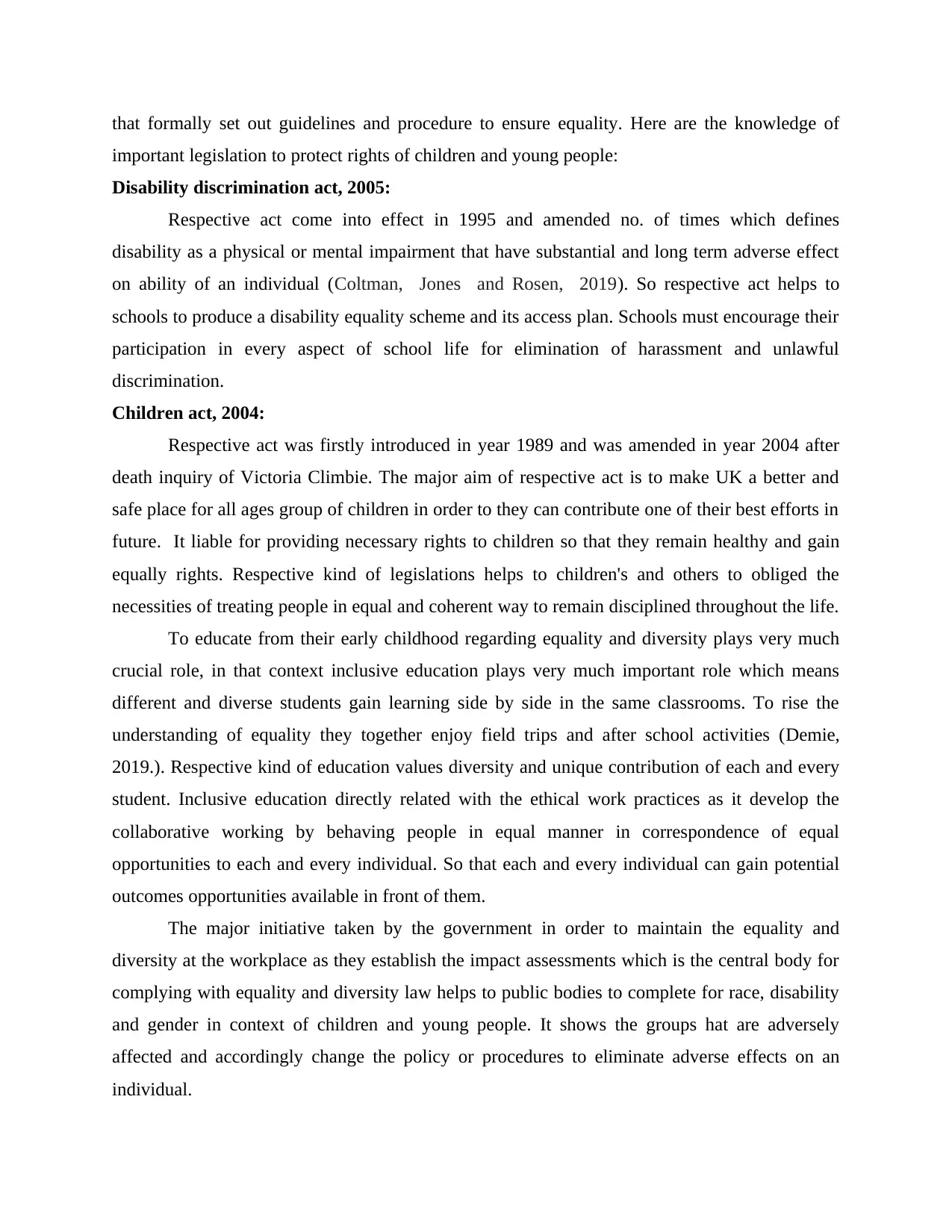
that formally set out guidelines and procedure to ensure equality. Here are the knowledge of
important legislation to protect rights of children and young people:
Disability discrimination act, 2005:
Respective act come into effect in 1995 and amended no. of times which defines
disability as a physical or mental impairment that have substantial and long term adverse effect
on ability of an individual (Coltman, Jones and Rosen, 2019). So respective act helps to
schools to produce a disability equality scheme and its access plan. Schools must encourage their
participation in every aspect of school life for elimination of harassment and unlawful
discrimination.
Children act, 2004:
Respective act was firstly introduced in year 1989 and was amended in year 2004 after
death inquiry of Victoria Climbie. The major aim of respective act is to make UK a better and
safe place for all ages group of children in order to they can contribute one of their best efforts in
future. It liable for providing necessary rights to children so that they remain healthy and gain
equally rights. Respective kind of legislations helps to children's and others to obliged the
necessities of treating people in equal and coherent way to remain disciplined throughout the life.
To educate from their early childhood regarding equality and diversity plays very much
crucial role, in that context inclusive education plays very much important role which means
different and diverse students gain learning side by side in the same classrooms. To rise the
understanding of equality they together enjoy field trips and after school activities (Demie,
2019.). Respective kind of education values diversity and unique contribution of each and every
student. Inclusive education directly related with the ethical work practices as it develop the
collaborative working by behaving people in equal manner in correspondence of equal
opportunities to each and every individual. So that each and every individual can gain potential
outcomes opportunities available in front of them.
The major initiative taken by the government in order to maintain the equality and
diversity at the workplace as they establish the impact assessments which is the central body for
complying with equality and diversity law helps to public bodies to complete for race, disability
and gender in context of children and young people. It shows the groups hat are adversely
affected and accordingly change the policy or procedures to eliminate adverse effects on an
individual.
important legislation to protect rights of children and young people:
Disability discrimination act, 2005:
Respective act come into effect in 1995 and amended no. of times which defines
disability as a physical or mental impairment that have substantial and long term adverse effect
on ability of an individual (Coltman, Jones and Rosen, 2019). So respective act helps to
schools to produce a disability equality scheme and its access plan. Schools must encourage their
participation in every aspect of school life for elimination of harassment and unlawful
discrimination.
Children act, 2004:
Respective act was firstly introduced in year 1989 and was amended in year 2004 after
death inquiry of Victoria Climbie. The major aim of respective act is to make UK a better and
safe place for all ages group of children in order to they can contribute one of their best efforts in
future. It liable for providing necessary rights to children so that they remain healthy and gain
equally rights. Respective kind of legislations helps to children's and others to obliged the
necessities of treating people in equal and coherent way to remain disciplined throughout the life.
To educate from their early childhood regarding equality and diversity plays very much
crucial role, in that context inclusive education plays very much important role which means
different and diverse students gain learning side by side in the same classrooms. To rise the
understanding of equality they together enjoy field trips and after school activities (Demie,
2019.). Respective kind of education values diversity and unique contribution of each and every
student. Inclusive education directly related with the ethical work practices as it develop the
collaborative working by behaving people in equal manner in correspondence of equal
opportunities to each and every individual. So that each and every individual can gain potential
outcomes opportunities available in front of them.
The major initiative taken by the government in order to maintain the equality and
diversity at the workplace as they establish the impact assessments which is the central body for
complying with equality and diversity law helps to public bodies to complete for race, disability
and gender in context of children and young people. It shows the groups hat are adversely
affected and accordingly change the policy or procedures to eliminate adverse effects on an
individual.
Secure Best Marks with AI Grader
Need help grading? Try our AI Grader for instant feedback on your assignments.
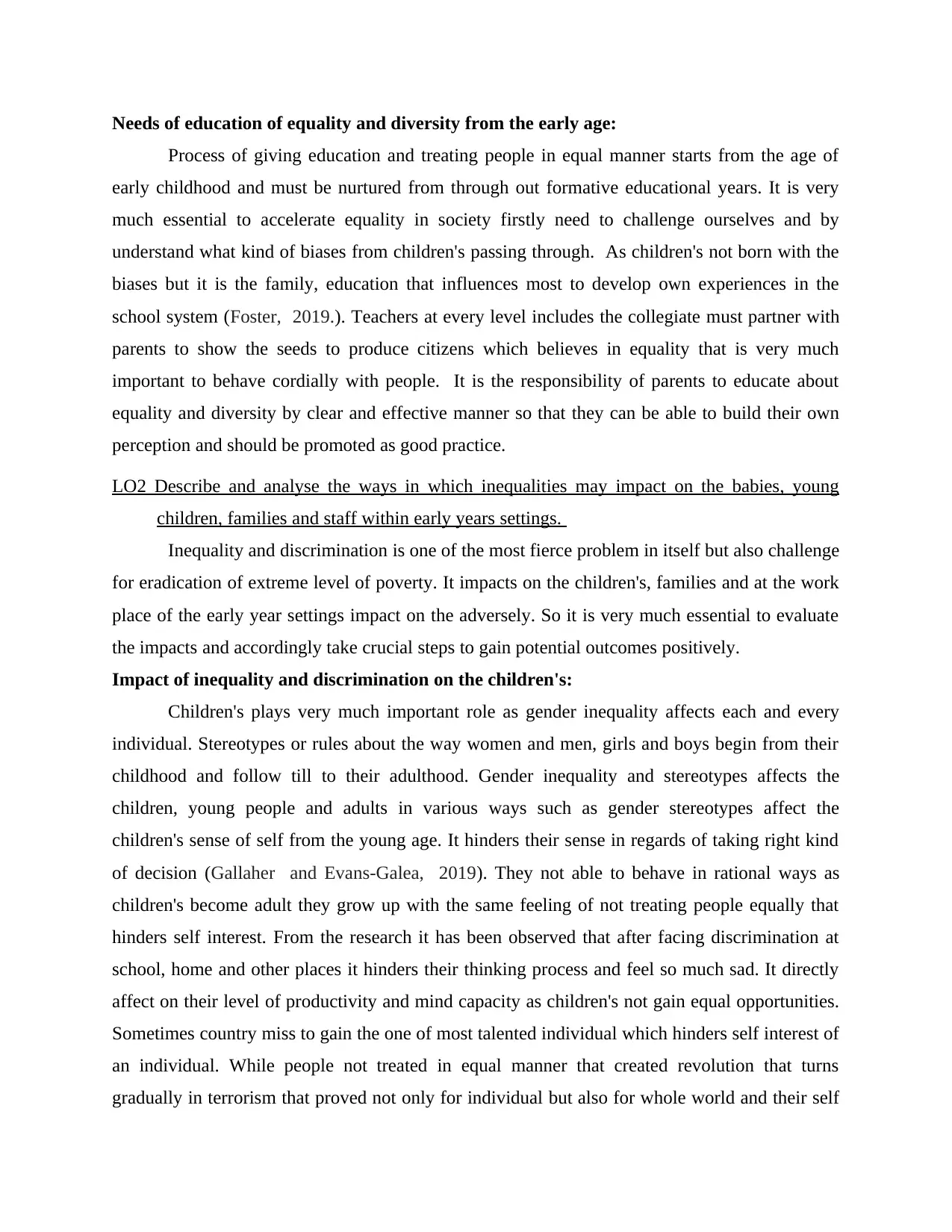
Needs of education of equality and diversity from the early age:
Process of giving education and treating people in equal manner starts from the age of
early childhood and must be nurtured from through out formative educational years. It is very
much essential to accelerate equality in society firstly need to challenge ourselves and by
understand what kind of biases from children's passing through. As children's not born with the
biases but it is the family, education that influences most to develop own experiences in the
school system (Foster, 2019.). Teachers at every level includes the collegiate must partner with
parents to show the seeds to produce citizens which believes in equality that is very much
important to behave cordially with people. It is the responsibility of parents to educate about
equality and diversity by clear and effective manner so that they can be able to build their own
perception and should be promoted as good practice.
LO2 Describe and analyse the ways in which inequalities may impact on the babies, young
children, families and staff within early years settings.
Inequality and discrimination is one of the most fierce problem in itself but also challenge
for eradication of extreme level of poverty. It impacts on the children's, families and at the work
place of the early year settings impact on the adversely. So it is very much essential to evaluate
the impacts and accordingly take crucial steps to gain potential outcomes positively.
Impact of inequality and discrimination on the children's:
Children's plays very much important role as gender inequality affects each and every
individual. Stereotypes or rules about the way women and men, girls and boys begin from their
childhood and follow till to their adulthood. Gender inequality and stereotypes affects the
children, young people and adults in various ways such as gender stereotypes affect the
children's sense of self from the young age. It hinders their sense in regards of taking right kind
of decision (Gallaher and Evans-Galea, 2019). They not able to behave in rational ways as
children's become adult they grow up with the same feeling of not treating people equally that
hinders self interest. From the research it has been observed that after facing discrimination at
school, home and other places it hinders their thinking process and feel so much sad. It directly
affect on their level of productivity and mind capacity as children's not gain equal opportunities.
Sometimes country miss to gain the one of most talented individual which hinders self interest of
an individual. While people not treated in equal manner that created revolution that turns
gradually in terrorism that proved not only for individual but also for whole world and their self
Process of giving education and treating people in equal manner starts from the age of
early childhood and must be nurtured from through out formative educational years. It is very
much essential to accelerate equality in society firstly need to challenge ourselves and by
understand what kind of biases from children's passing through. As children's not born with the
biases but it is the family, education that influences most to develop own experiences in the
school system (Foster, 2019.). Teachers at every level includes the collegiate must partner with
parents to show the seeds to produce citizens which believes in equality that is very much
important to behave cordially with people. It is the responsibility of parents to educate about
equality and diversity by clear and effective manner so that they can be able to build their own
perception and should be promoted as good practice.
LO2 Describe and analyse the ways in which inequalities may impact on the babies, young
children, families and staff within early years settings.
Inequality and discrimination is one of the most fierce problem in itself but also challenge
for eradication of extreme level of poverty. It impacts on the children's, families and at the work
place of the early year settings impact on the adversely. So it is very much essential to evaluate
the impacts and accordingly take crucial steps to gain potential outcomes positively.
Impact of inequality and discrimination on the children's:
Children's plays very much important role as gender inequality affects each and every
individual. Stereotypes or rules about the way women and men, girls and boys begin from their
childhood and follow till to their adulthood. Gender inequality and stereotypes affects the
children, young people and adults in various ways such as gender stereotypes affect the
children's sense of self from the young age. It hinders their sense in regards of taking right kind
of decision (Gallaher and Evans-Galea, 2019). They not able to behave in rational ways as
children's become adult they grow up with the same feeling of not treating people equally that
hinders self interest. From the research it has been observed that after facing discrimination at
school, home and other places it hinders their thinking process and feel so much sad. It directly
affect on their level of productivity and mind capacity as children's not gain equal opportunities.
Sometimes country miss to gain the one of most talented individual which hinders self interest of
an individual. While people not treated in equal manner that created revolution that turns
gradually in terrorism that proved not only for individual but also for whole world and their self
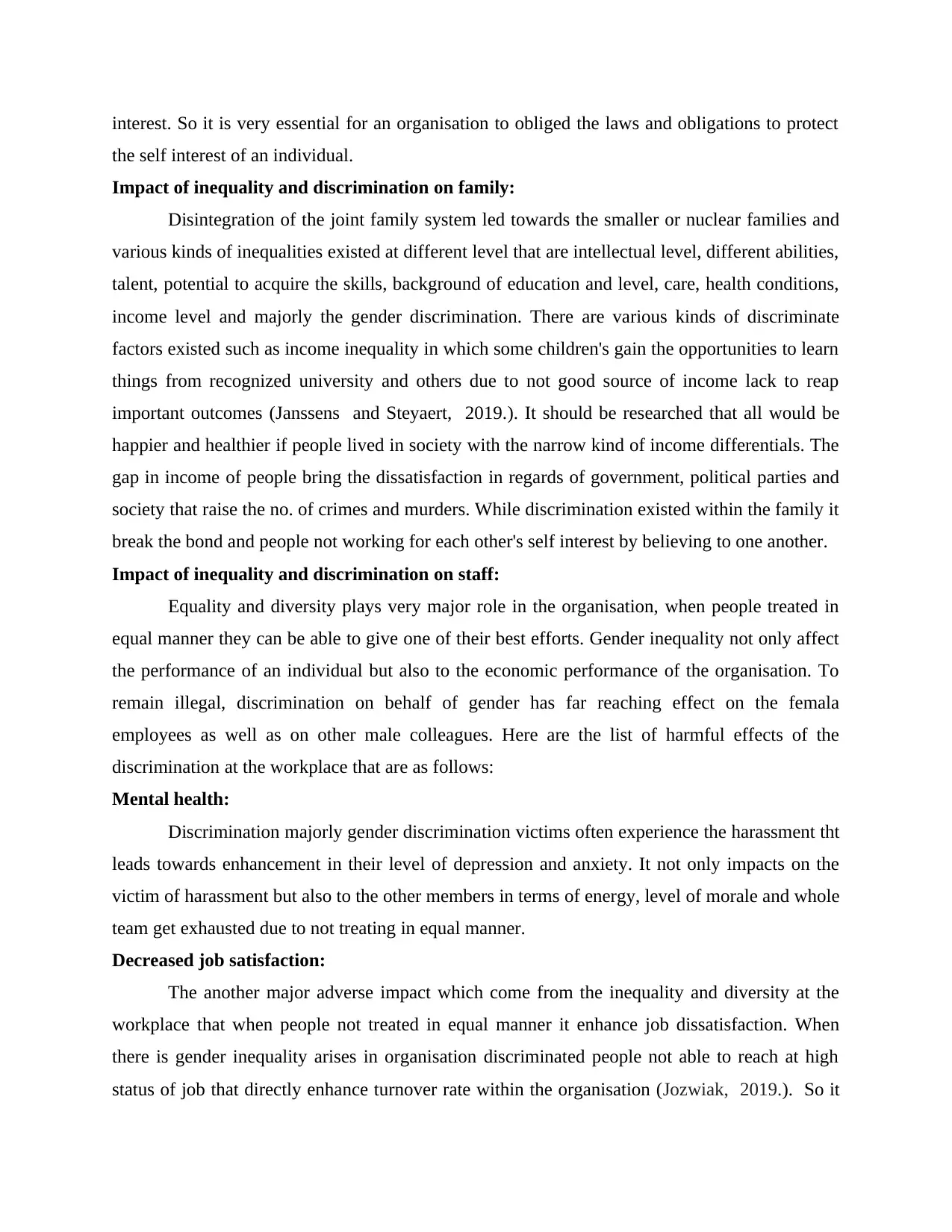
interest. So it is very essential for an organisation to obliged the laws and obligations to protect
the self interest of an individual.
Impact of inequality and discrimination on family:
Disintegration of the joint family system led towards the smaller or nuclear families and
various kinds of inequalities existed at different level that are intellectual level, different abilities,
talent, potential to acquire the skills, background of education and level, care, health conditions,
income level and majorly the gender discrimination. There are various kinds of discriminate
factors existed such as income inequality in which some children's gain the opportunities to learn
things from recognized university and others due to not good source of income lack to reap
important outcomes (Janssens and Steyaert, 2019.). It should be researched that all would be
happier and healthier if people lived in society with the narrow kind of income differentials. The
gap in income of people bring the dissatisfaction in regards of government, political parties and
society that raise the no. of crimes and murders. While discrimination existed within the family it
break the bond and people not working for each other's self interest by believing to one another.
Impact of inequality and discrimination on staff:
Equality and diversity plays very major role in the organisation, when people treated in
equal manner they can be able to give one of their best efforts. Gender inequality not only affect
the performance of an individual but also to the economic performance of the organisation. To
remain illegal, discrimination on behalf of gender has far reaching effect on the femala
employees as well as on other male colleagues. Here are the list of harmful effects of the
discrimination at the workplace that are as follows:
Mental health:
Discrimination majorly gender discrimination victims often experience the harassment tht
leads towards enhancement in their level of depression and anxiety. It not only impacts on the
victim of harassment but also to the other members in terms of energy, level of morale and whole
team get exhausted due to not treating in equal manner.
Decreased job satisfaction:
The another major adverse impact which come from the inequality and diversity at the
workplace that when people not treated in equal manner it enhance job dissatisfaction. When
there is gender inequality arises in organisation discriminated people not able to reach at high
status of job that directly enhance turnover rate within the organisation (Jozwiak, 2019.). So it
the self interest of an individual.
Impact of inequality and discrimination on family:
Disintegration of the joint family system led towards the smaller or nuclear families and
various kinds of inequalities existed at different level that are intellectual level, different abilities,
talent, potential to acquire the skills, background of education and level, care, health conditions,
income level and majorly the gender discrimination. There are various kinds of discriminate
factors existed such as income inequality in which some children's gain the opportunities to learn
things from recognized university and others due to not good source of income lack to reap
important outcomes (Janssens and Steyaert, 2019.). It should be researched that all would be
happier and healthier if people lived in society with the narrow kind of income differentials. The
gap in income of people bring the dissatisfaction in regards of government, political parties and
society that raise the no. of crimes and murders. While discrimination existed within the family it
break the bond and people not working for each other's self interest by believing to one another.
Impact of inequality and discrimination on staff:
Equality and diversity plays very major role in the organisation, when people treated in
equal manner they can be able to give one of their best efforts. Gender inequality not only affect
the performance of an individual but also to the economic performance of the organisation. To
remain illegal, discrimination on behalf of gender has far reaching effect on the femala
employees as well as on other male colleagues. Here are the list of harmful effects of the
discrimination at the workplace that are as follows:
Mental health:
Discrimination majorly gender discrimination victims often experience the harassment tht
leads towards enhancement in their level of depression and anxiety. It not only impacts on the
victim of harassment but also to the other members in terms of energy, level of morale and whole
team get exhausted due to not treating in equal manner.
Decreased job satisfaction:
The another major adverse impact which come from the inequality and diversity at the
workplace that when people not treated in equal manner it enhance job dissatisfaction. When
there is gender inequality arises in organisation discriminated people not able to reach at high
status of job that directly enhance turnover rate within the organisation (Jozwiak, 2019.). So it
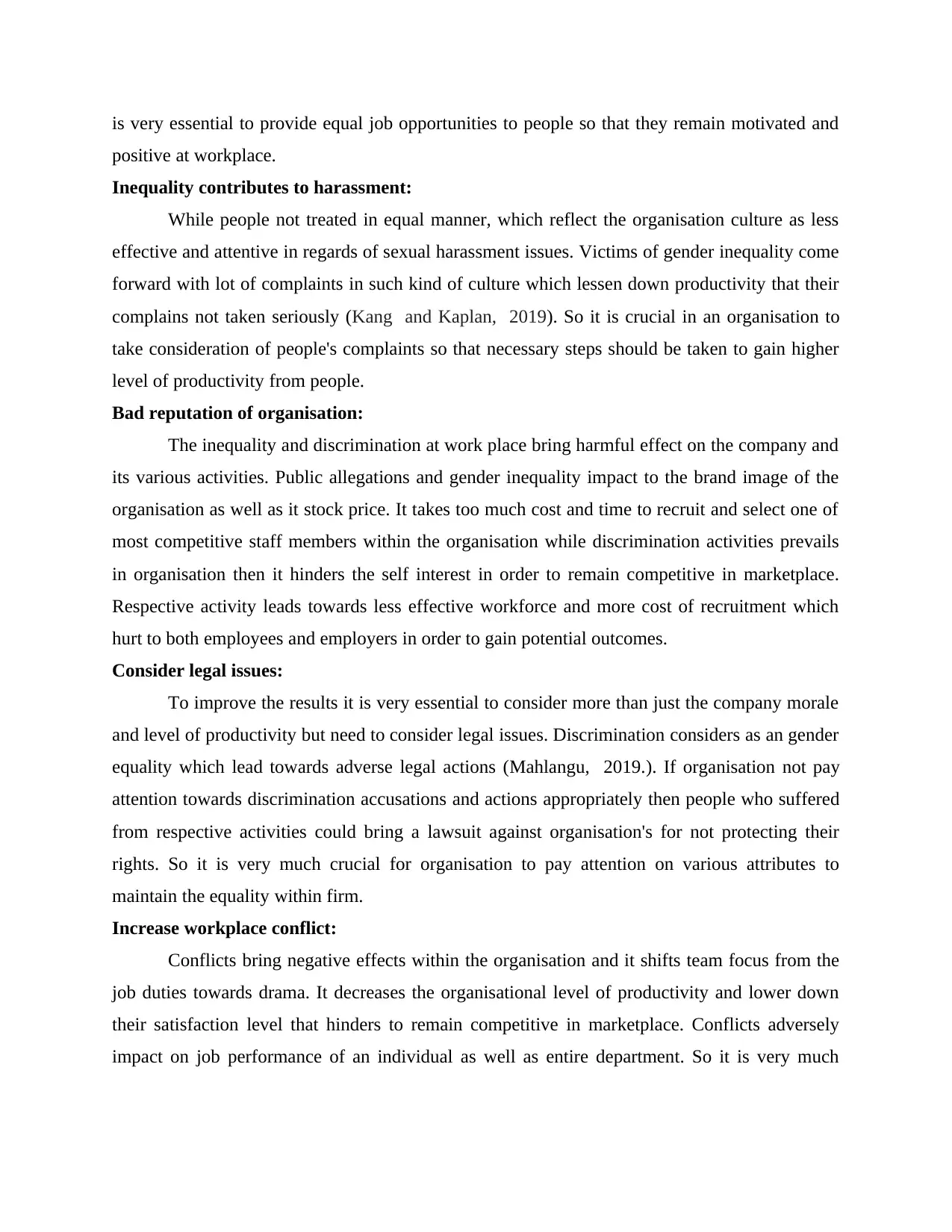
is very essential to provide equal job opportunities to people so that they remain motivated and
positive at workplace.
Inequality contributes to harassment:
While people not treated in equal manner, which reflect the organisation culture as less
effective and attentive in regards of sexual harassment issues. Victims of gender inequality come
forward with lot of complaints in such kind of culture which lessen down productivity that their
complains not taken seriously (Kang and Kaplan, 2019). So it is crucial in an organisation to
take consideration of people's complaints so that necessary steps should be taken to gain higher
level of productivity from people.
Bad reputation of organisation:
The inequality and discrimination at work place bring harmful effect on the company and
its various activities. Public allegations and gender inequality impact to the brand image of the
organisation as well as it stock price. It takes too much cost and time to recruit and select one of
most competitive staff members within the organisation while discrimination activities prevails
in organisation then it hinders the self interest in order to remain competitive in marketplace.
Respective activity leads towards less effective workforce and more cost of recruitment which
hurt to both employees and employers in order to gain potential outcomes.
Consider legal issues:
To improve the results it is very essential to consider more than just the company morale
and level of productivity but need to consider legal issues. Discrimination considers as an gender
equality which lead towards adverse legal actions (Mahlangu, 2019.). If organisation not pay
attention towards discrimination accusations and actions appropriately then people who suffered
from respective activities could bring a lawsuit against organisation's for not protecting their
rights. So it is very much crucial for organisation to pay attention on various attributes to
maintain the equality within firm.
Increase workplace conflict:
Conflicts bring negative effects within the organisation and it shifts team focus from the
job duties towards drama. It decreases the organisational level of productivity and lower down
their satisfaction level that hinders to remain competitive in marketplace. Conflicts adversely
impact on job performance of an individual as well as entire department. So it is very much
positive at workplace.
Inequality contributes to harassment:
While people not treated in equal manner, which reflect the organisation culture as less
effective and attentive in regards of sexual harassment issues. Victims of gender inequality come
forward with lot of complaints in such kind of culture which lessen down productivity that their
complains not taken seriously (Kang and Kaplan, 2019). So it is crucial in an organisation to
take consideration of people's complaints so that necessary steps should be taken to gain higher
level of productivity from people.
Bad reputation of organisation:
The inequality and discrimination at work place bring harmful effect on the company and
its various activities. Public allegations and gender inequality impact to the brand image of the
organisation as well as it stock price. It takes too much cost and time to recruit and select one of
most competitive staff members within the organisation while discrimination activities prevails
in organisation then it hinders the self interest in order to remain competitive in marketplace.
Respective activity leads towards less effective workforce and more cost of recruitment which
hurt to both employees and employers in order to gain potential outcomes.
Consider legal issues:
To improve the results it is very essential to consider more than just the company morale
and level of productivity but need to consider legal issues. Discrimination considers as an gender
equality which lead towards adverse legal actions (Mahlangu, 2019.). If organisation not pay
attention towards discrimination accusations and actions appropriately then people who suffered
from respective activities could bring a lawsuit against organisation's for not protecting their
rights. So it is very much crucial for organisation to pay attention on various attributes to
maintain the equality within firm.
Increase workplace conflict:
Conflicts bring negative effects within the organisation and it shifts team focus from the
job duties towards drama. It decreases the organisational level of productivity and lower down
their satisfaction level that hinders to remain competitive in marketplace. Conflicts adversely
impact on job performance of an individual as well as entire department. So it is very much
Paraphrase This Document
Need a fresh take? Get an instant paraphrase of this document with our AI Paraphraser
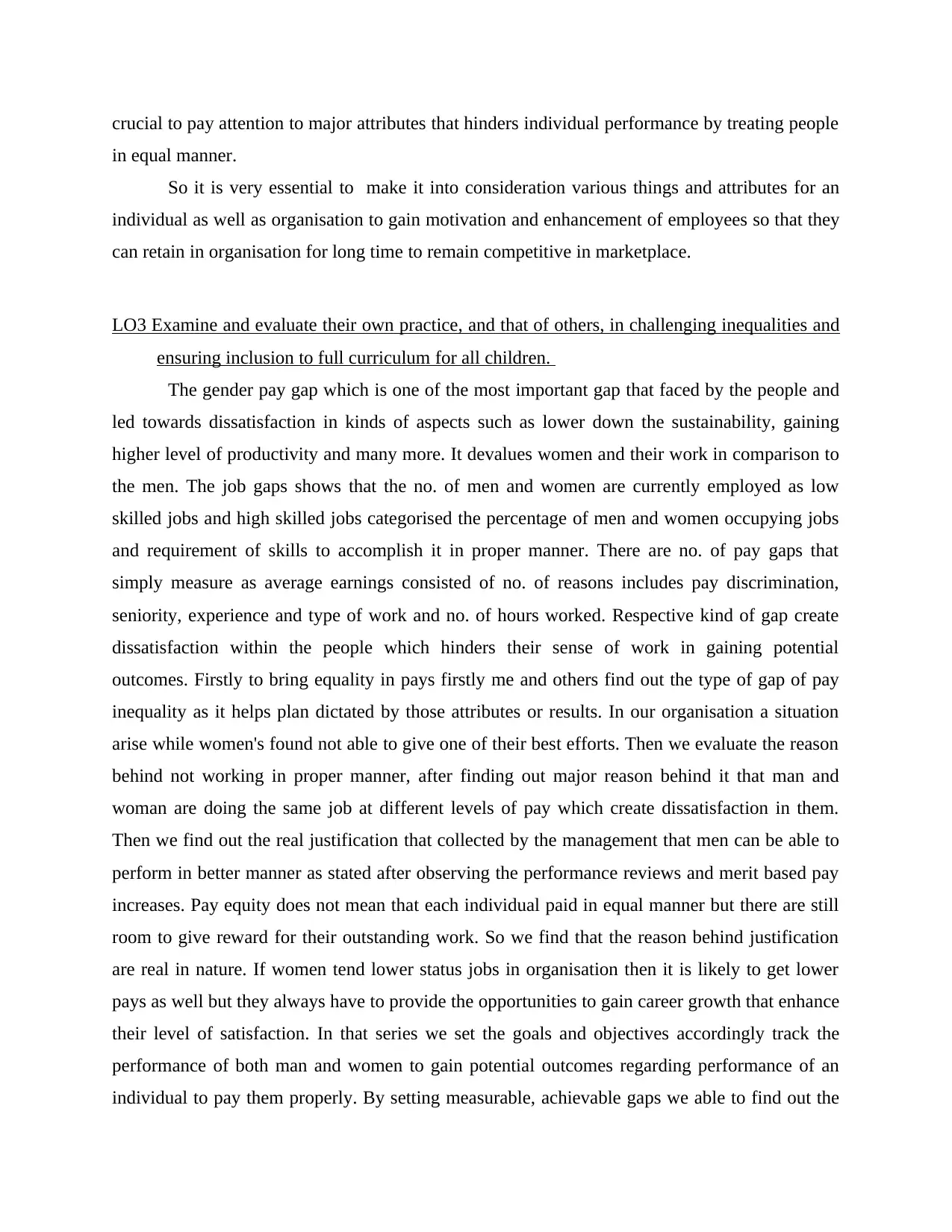
crucial to pay attention to major attributes that hinders individual performance by treating people
in equal manner.
So it is very essential to make it into consideration various things and attributes for an
individual as well as organisation to gain motivation and enhancement of employees so that they
can retain in organisation for long time to remain competitive in marketplace.
LO3 Examine and evaluate their own practice, and that of others, in challenging inequalities and
ensuring inclusion to full curriculum for all children.
The gender pay gap which is one of the most important gap that faced by the people and
led towards dissatisfaction in kinds of aspects such as lower down the sustainability, gaining
higher level of productivity and many more. It devalues women and their work in comparison to
the men. The job gaps shows that the no. of men and women are currently employed as low
skilled jobs and high skilled jobs categorised the percentage of men and women occupying jobs
and requirement of skills to accomplish it in proper manner. There are no. of pay gaps that
simply measure as average earnings consisted of no. of reasons includes pay discrimination,
seniority, experience and type of work and no. of hours worked. Respective kind of gap create
dissatisfaction within the people which hinders their sense of work in gaining potential
outcomes. Firstly to bring equality in pays firstly me and others find out the type of gap of pay
inequality as it helps plan dictated by those attributes or results. In our organisation a situation
arise while women's found not able to give one of their best efforts. Then we evaluate the reason
behind not working in proper manner, after finding out major reason behind it that man and
woman are doing the same job at different levels of pay which create dissatisfaction in them.
Then we find out the real justification that collected by the management that men can be able to
perform in better manner as stated after observing the performance reviews and merit based pay
increases. Pay equity does not mean that each individual paid in equal manner but there are still
room to give reward for their outstanding work. So we find that the reason behind justification
are real in nature. If women tend lower status jobs in organisation then it is likely to get lower
pays as well but they always have to provide the opportunities to gain career growth that enhance
their level of satisfaction. In that series we set the goals and objectives accordingly track the
performance of both man and women to gain potential outcomes regarding performance of an
individual to pay them properly. By setting measurable, achievable gaps we able to find out the
in equal manner.
So it is very essential to make it into consideration various things and attributes for an
individual as well as organisation to gain motivation and enhancement of employees so that they
can retain in organisation for long time to remain competitive in marketplace.
LO3 Examine and evaluate their own practice, and that of others, in challenging inequalities and
ensuring inclusion to full curriculum for all children.
The gender pay gap which is one of the most important gap that faced by the people and
led towards dissatisfaction in kinds of aspects such as lower down the sustainability, gaining
higher level of productivity and many more. It devalues women and their work in comparison to
the men. The job gaps shows that the no. of men and women are currently employed as low
skilled jobs and high skilled jobs categorised the percentage of men and women occupying jobs
and requirement of skills to accomplish it in proper manner. There are no. of pay gaps that
simply measure as average earnings consisted of no. of reasons includes pay discrimination,
seniority, experience and type of work and no. of hours worked. Respective kind of gap create
dissatisfaction within the people which hinders their sense of work in gaining potential
outcomes. Firstly to bring equality in pays firstly me and others find out the type of gap of pay
inequality as it helps plan dictated by those attributes or results. In our organisation a situation
arise while women's found not able to give one of their best efforts. Then we evaluate the reason
behind not working in proper manner, after finding out major reason behind it that man and
woman are doing the same job at different levels of pay which create dissatisfaction in them.
Then we find out the real justification that collected by the management that men can be able to
perform in better manner as stated after observing the performance reviews and merit based pay
increases. Pay equity does not mean that each individual paid in equal manner but there are still
room to give reward for their outstanding work. So we find that the reason behind justification
are real in nature. If women tend lower status jobs in organisation then it is likely to get lower
pays as well but they always have to provide the opportunities to gain career growth that enhance
their level of satisfaction. In that series we set the goals and objectives accordingly track the
performance of both man and women to gain potential outcomes regarding performance of an
individual to pay them properly. By setting measurable, achievable gaps we able to find out the

capabilities of an individual so that employees can achieve one of best remuneration in against
the work performed by them. By using data that available within the organisation that helps to
reach at decisive kind of content pay in equal manner. But it proved hard for us to collect
information about salary of people as it is private and our company also follow the rule to not
discussing the salary with others. We also take responsibility to build awareness to involve them
so that promptly results should be achieved. By using cross section of employees and company
as an whole brainstorming helps us to evaluate various hidden factors for crucial decision-
making. After gaining the support of no. of people we able to gain large no. of data and
information regarding their experience, salary, targets they achieve and no. of hours working
many more. While we set goals and objectives then we observed that women's give one of their
best efforts and efficiently gain potential outcomes. So it can be said that treating men and
women in equally manner is very much potential for gaining productivity and motivation of
people that plays very much important role for an individual as well as for organisation to remain
competitive in marketplace. So respective activity proved beneficial for us also as it enhance my
level of confidence and acknowledge the way to collect information and use in right direction.
By reaching at desirable goal which is provide equal pay for equal pay so that each and every
individual can give one of their best efforts in organisation development and enhancement in
positive manner.
CONCLUSION
From the above report it has been concluded that equality and diversity plays very much
important role in life of an individual to behave in ethical manner. It is very crucial to give
proper education to children's from very early age as it helps to build their mindset and level of
perception and actions. It is essential to build the laws that save the right of an individual and
helps to give one of best efforts. The inequality and discrimination activities impact on the
individuals, staff and families so it is very crucial to take necessary steps to provide knowledge
and information to eliminate the effects of them. The reflective section of respective report state
about the in inequality in pay so by collecting necessary information organisation and members
can achieve desirable outcomes.
the work performed by them. By using data that available within the organisation that helps to
reach at decisive kind of content pay in equal manner. But it proved hard for us to collect
information about salary of people as it is private and our company also follow the rule to not
discussing the salary with others. We also take responsibility to build awareness to involve them
so that promptly results should be achieved. By using cross section of employees and company
as an whole brainstorming helps us to evaluate various hidden factors for crucial decision-
making. After gaining the support of no. of people we able to gain large no. of data and
information regarding their experience, salary, targets they achieve and no. of hours working
many more. While we set goals and objectives then we observed that women's give one of their
best efforts and efficiently gain potential outcomes. So it can be said that treating men and
women in equally manner is very much potential for gaining productivity and motivation of
people that plays very much important role for an individual as well as for organisation to remain
competitive in marketplace. So respective activity proved beneficial for us also as it enhance my
level of confidence and acknowledge the way to collect information and use in right direction.
By reaching at desirable goal which is provide equal pay for equal pay so that each and every
individual can give one of their best efforts in organisation development and enhancement in
positive manner.
CONCLUSION
From the above report it has been concluded that equality and diversity plays very much
important role in life of an individual to behave in ethical manner. It is very crucial to give
proper education to children's from very early age as it helps to build their mindset and level of
perception and actions. It is essential to build the laws that save the right of an individual and
helps to give one of best efforts. The inequality and discrimination activities impact on the
individuals, staff and families so it is very crucial to take necessary steps to provide knowledge
and information to eliminate the effects of them. The reflective section of respective report state
about the in inequality in pay so by collecting necessary information organisation and members
can achieve desirable outcomes.
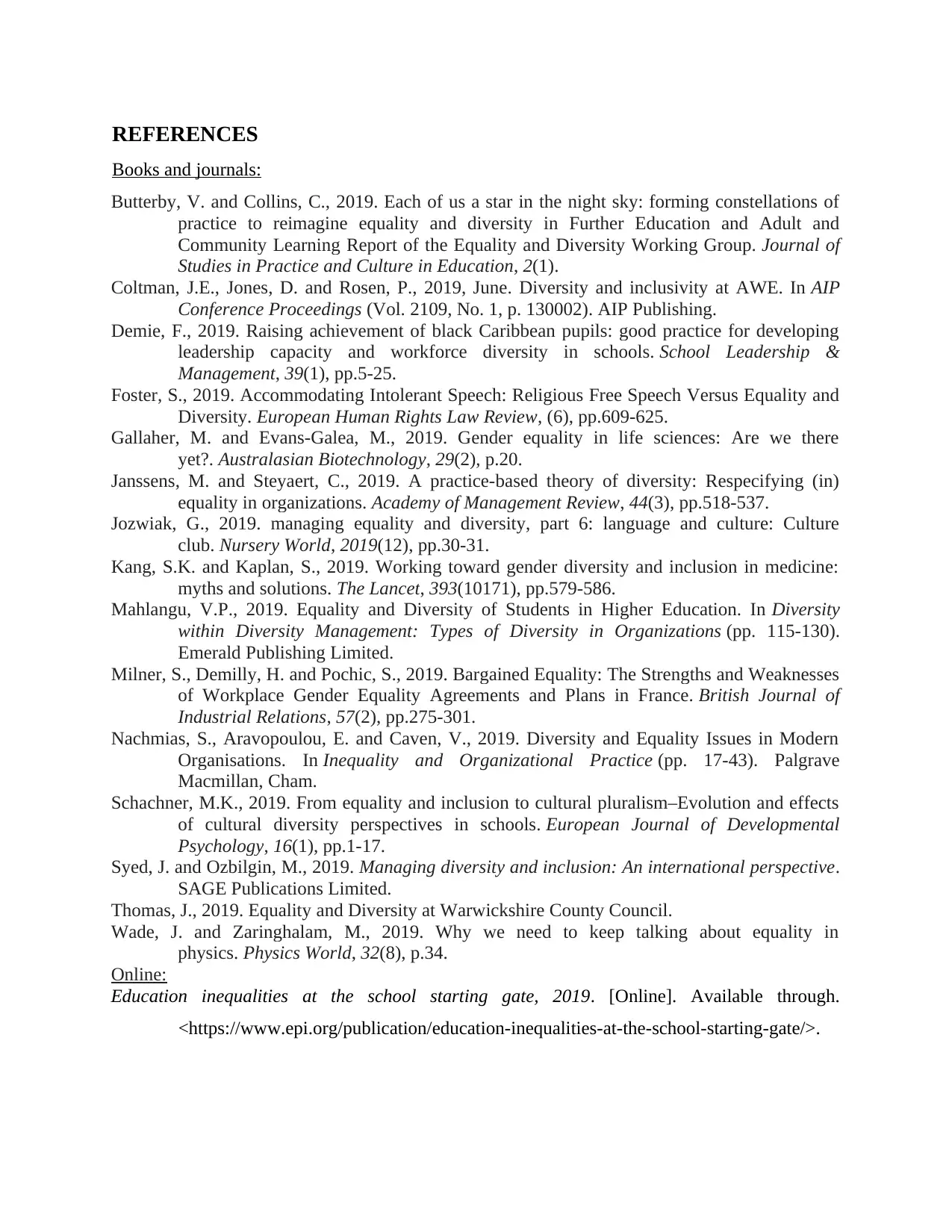
REFERENCES
Books and journals:
Butterby, V. and Collins, C., 2019. Each of us a star in the night sky: forming constellations of
practice to reimagine equality and diversity in Further Education and Adult and
Community Learning Report of the Equality and Diversity Working Group. Journal of
Studies in Practice and Culture in Education, 2(1).
Coltman, J.E., Jones, D. and Rosen, P., 2019, June. Diversity and inclusivity at AWE. In AIP
Conference Proceedings (Vol. 2109, No. 1, p. 130002). AIP Publishing.
Demie, F., 2019. Raising achievement of black Caribbean pupils: good practice for developing
leadership capacity and workforce diversity in schools. School Leadership &
Management, 39(1), pp.5-25.
Foster, S., 2019. Accommodating Intolerant Speech: Religious Free Speech Versus Equality and
Diversity. European Human Rights Law Review, (6), pp.609-625.
Gallaher, M. and Evans-Galea, M., 2019. Gender equality in life sciences: Are we there
yet?. Australasian Biotechnology, 29(2), p.20.
Janssens, M. and Steyaert, C., 2019. A practice-based theory of diversity: Respecifying (in)
equality in organizations. Academy of Management Review, 44(3), pp.518-537.
Jozwiak, G., 2019. managing equality and diversity, part 6: language and culture: Culture
club. Nursery World, 2019(12), pp.30-31.
Kang, S.K. and Kaplan, S., 2019. Working toward gender diversity and inclusion in medicine:
myths and solutions. The Lancet, 393(10171), pp.579-586.
Mahlangu, V.P., 2019. Equality and Diversity of Students in Higher Education. In Diversity
within Diversity Management: Types of Diversity in Organizations (pp. 115-130).
Emerald Publishing Limited.
Milner, S., Demilly, H. and Pochic, S., 2019. Bargained Equality: The Strengths and Weaknesses
of Workplace Gender Equality Agreements and Plans in France. British Journal of
Industrial Relations, 57(2), pp.275-301.
Nachmias, S., Aravopoulou, E. and Caven, V., 2019. Diversity and Equality Issues in Modern
Organisations. In Inequality and Organizational Practice (pp. 17-43). Palgrave
Macmillan, Cham.
Schachner, M.K., 2019. From equality and inclusion to cultural pluralism–Evolution and effects
of cultural diversity perspectives in schools. European Journal of Developmental
Psychology, 16(1), pp.1-17.
Syed, J. and Ozbilgin, M., 2019. Managing diversity and inclusion: An international perspective.
SAGE Publications Limited.
Thomas, J., 2019. Equality and Diversity at Warwickshire County Council.
Wade, J. and Zaringhalam, M., 2019. Why we need to keep talking about equality in
physics. Physics World, 32(8), p.34.
Online:
Education inequalities at the school starting gate, 2019. [Online]. Available through.
<https://www.epi.org/publication/education-inequalities-at-the-school-starting-gate/>.
Books and journals:
Butterby, V. and Collins, C., 2019. Each of us a star in the night sky: forming constellations of
practice to reimagine equality and diversity in Further Education and Adult and
Community Learning Report of the Equality and Diversity Working Group. Journal of
Studies in Practice and Culture in Education, 2(1).
Coltman, J.E., Jones, D. and Rosen, P., 2019, June. Diversity and inclusivity at AWE. In AIP
Conference Proceedings (Vol. 2109, No. 1, p. 130002). AIP Publishing.
Demie, F., 2019. Raising achievement of black Caribbean pupils: good practice for developing
leadership capacity and workforce diversity in schools. School Leadership &
Management, 39(1), pp.5-25.
Foster, S., 2019. Accommodating Intolerant Speech: Religious Free Speech Versus Equality and
Diversity. European Human Rights Law Review, (6), pp.609-625.
Gallaher, M. and Evans-Galea, M., 2019. Gender equality in life sciences: Are we there
yet?. Australasian Biotechnology, 29(2), p.20.
Janssens, M. and Steyaert, C., 2019. A practice-based theory of diversity: Respecifying (in)
equality in organizations. Academy of Management Review, 44(3), pp.518-537.
Jozwiak, G., 2019. managing equality and diversity, part 6: language and culture: Culture
club. Nursery World, 2019(12), pp.30-31.
Kang, S.K. and Kaplan, S., 2019. Working toward gender diversity and inclusion in medicine:
myths and solutions. The Lancet, 393(10171), pp.579-586.
Mahlangu, V.P., 2019. Equality and Diversity of Students in Higher Education. In Diversity
within Diversity Management: Types of Diversity in Organizations (pp. 115-130).
Emerald Publishing Limited.
Milner, S., Demilly, H. and Pochic, S., 2019. Bargained Equality: The Strengths and Weaknesses
of Workplace Gender Equality Agreements and Plans in France. British Journal of
Industrial Relations, 57(2), pp.275-301.
Nachmias, S., Aravopoulou, E. and Caven, V., 2019. Diversity and Equality Issues in Modern
Organisations. In Inequality and Organizational Practice (pp. 17-43). Palgrave
Macmillan, Cham.
Schachner, M.K., 2019. From equality and inclusion to cultural pluralism–Evolution and effects
of cultural diversity perspectives in schools. European Journal of Developmental
Psychology, 16(1), pp.1-17.
Syed, J. and Ozbilgin, M., 2019. Managing diversity and inclusion: An international perspective.
SAGE Publications Limited.
Thomas, J., 2019. Equality and Diversity at Warwickshire County Council.
Wade, J. and Zaringhalam, M., 2019. Why we need to keep talking about equality in
physics. Physics World, 32(8), p.34.
Online:
Education inequalities at the school starting gate, 2019. [Online]. Available through.
<https://www.epi.org/publication/education-inequalities-at-the-school-starting-gate/>.
Secure Best Marks with AI Grader
Need help grading? Try our AI Grader for instant feedback on your assignments.


1
1 out of 12
Related Documents
Your All-in-One AI-Powered Toolkit for Academic Success.
+13062052269
info@desklib.com
Available 24*7 on WhatsApp / Email
![[object Object]](/_next/static/media/star-bottom.7253800d.svg)
Unlock your academic potential
© 2024 | Zucol Services PVT LTD | All rights reserved.





